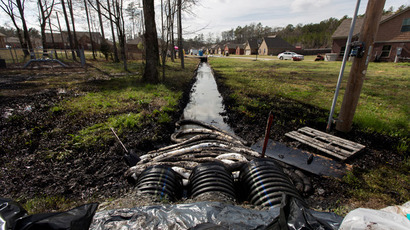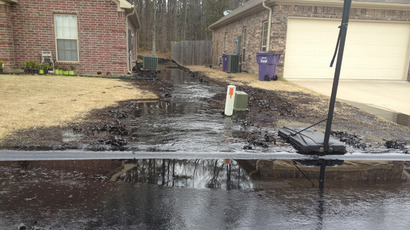Arkansas oil spill: Timeline
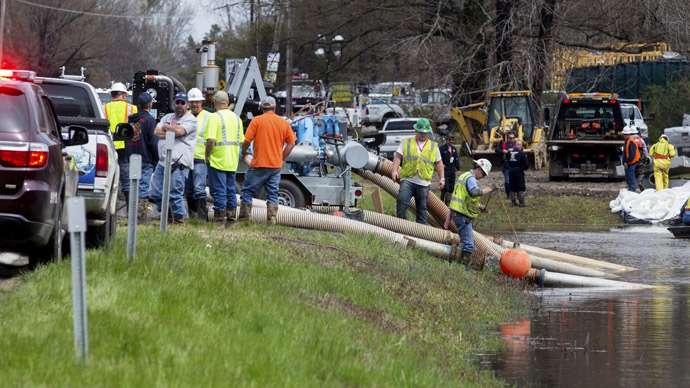
Friday marks one week since an ExxonMobil pipeline burst in the town of Mayflower, Arkansas, spilling thousands of barrels of toxic tar sands. Town residents say they are being kept in the dark over compensation and the cleanup by Exxon.
April 14
ExxonMobil has compelled media outlets in Arkansas to pull a satirical advertisement critical of its business practices calling it “defamatory.” The ad is part of the ongoing campaign by ExxonHatesYourChildren.com that tries to educate the public about how taxpayers subsidize fossil fuel companies like Exxon.
Meanwhile, the Arkansas Department of Health approved a re-entry plan for 10 homes in the evacuated area, Mayflower Incident Unified Command Joint Information Center said Sunday.
In addition, at least 26 private residences and public buildings have been cleared.
ExxonMobil is developing a plan to address concerns about the long-term value of homes in the North Woods neighbourhood, including the possibility of buying up the properties. 237 claims have been made as of April 12.
April 11
No oil-contaminated water has spilled outside the surrounding perimeter area of Lake Conway following a heavy rain storm in Arkansas, the Mayflower Incident Unified Command Joint Information Center announced on Thursday, as the clean-up continues.
The Arkansas Department of Health has allowed up to 10 families to return to their homes in the evacuated area following indoor air monitoring. Meanwhile, 208 insurance claims have been made as of April 10.
Pipe operator, ExxonMobil anticipates the damaged segment of the pipe will be removed this week to be sent to an independent third-party laboratory for metallurgy testing.
April 10
Most of the free-standing oil has been recovered at the site of the oil spill in Mayflower, according to an update by Exxon on the cleanup efforts. Severe storms were forecast for the day, so emergency responders worked to ensure the safety of the equipment and people. Exxon also reported that the evacuation of nearby residents is continuing. Monitoring of the area’s air quality has not shown an increase in any health hazards.
The emergency response also involves recovering wild animals that suffered from the oil spill:
“Approximately 140 live animals have been captured to date. Thirteen animals of various species have been released and approximately 27 are still being cleaned,” Exxon said. The majority of the wildlife captured was reptiles, mostly venomous snakes. About 700 people are currently working on the cleanup. Around 28,200 barrels of oily water have been recovered from the site, with 5,000 barrels of oil initially spilled. The cause of the incident is still under investigation.
“@kxlblockade: Wetlands in #Mayflower destroyed by #Exxon#tarsands twitter.com/KXLBlockade/st…”
— Occupy Tar Sands (@OccupyTarSands) 11 апреля 2013 г.
A popular blog based out of Arkansas revealed today that at least 19 local law enforcement officers are working on behalf of ExxonMobil in uniform as private security. According to the Mayflower Police Department, three or four officers are involved.
Police Chief Bob Satkowski confirmed that Exxon required the officers to wear their uniforms, though a spokeswoman with the company stated via email that they believed whether an off-duty officer wore a uniform was up to the individual.
“I feel like these officers have a real conflict of interest,” said Mickey H. Osterreicher, general counsel for the National Press Photographers Association. Police and deputies working off-duty shouldn’t just do everything Exxon says to do, he said.
April 9
The recovery and clean-up team involves some 700 people including federal, state and local personnel. The authorities are now preparing a contingency plan for the storm forecast for Wednesday, which includes securing equipment and strengthening a containment system protecting Lake Conway, Mayflower Incident Unified Command Joint Information Center said in new press release.
Some wildlife, surrounding the contaminated area has suffered as twenty-three ducks, a nutria, and five turtles died on Tuesday. Air quality samples by the US Environmental Protection Agency and ExxonMobil are being reviewed by the Arkansas Department of Health in a continued effort to return the families to their homes.
So far about 28,000 barrels of oily water have been recovered, according to the Unified Command estimates.
April 8
Four residents have been allowed to return to their homes in Mayflower after the Arkansas Department of Health conducted air quality tests around the residences, the Mayflower Incident Unified Command Joint Information Center said in a press release. The remaining 18 homes need to be cleaned before residents can return.
ExxonMobil has agreed to fund the cleanup effort and has promised to process all valid insurance claims. The oil giant has also opened a hotline for residents affected by the spill. So far, about 157 claims have been made as of April 8.
Environmental authorities said that the fish in the main lake in the region have not been affected while tests on water samples show Lake Conway to be oil-free and is safe to drink.
April 7
Members of Pipeliners Union 798 told Mayflower residents that negligence on the part of ExxonMobile is to blame for the recent oil spill during a meeting with homeowners on Saturday.
"The companies like ExxonMobile, they don't want to spend the money to fix these old lines. Fifty percent of the lines in the United States were built in the 50s and 60s and they're worn out," CBS affiliate THV 11 cites union member Danny Hendrix as saying.
The Pipeliners Union presented 22 families displaced by the pipeline rupture with checks for $1000.
ExxonMobile responded to the claims, saying the pipeline, which is inspected using inline inspection tools, is monitored by the company’s control center in Houston. The oil giant further stated that it follows “the regulatory requirements for inspection and maintenance of that pipeline."
April 6
A Mayflower beekeeper has found dead bees soaked in oil outside her hive, local news agency KARK reports. The insects have been apparently pollinating plants in the polluted area. The beekeeper has since called the Arkansas Plant Board and an emergency evacuation is taking place to remove the bees.
Soil sampling in my neighbors back yard. This was taken over my back fence. #oilspill twitter.com/shiftymcfive01…
— chris harrell (@shiftymcfive01) April 6, 2013
Two women hailing from Mayflower, Arkansas have filed the first lawsuit against ExxonMobil in connection with last week’s oil spill. Attorneys for Kimla Greene and Kathryn Jane Roachell Chunn filed the lawsuit in federal court Friday.
According to the lawsuit, a change in the type of oil and the direction of flow helped to rupture the pipeline, which caused the major spill, and therefore ExxonMobil “are strictly liable for ultra-hazardous conditions that proximately cause injuries to people," reports local TV channel KTHV.
ExxonMobile is being asked to pay “for damages caused by Defendants' strict (absolute) liability in an amount in excess of $75,000.00, exclusive of costs and interest for individual damages in excess of $5,000,000.00 of costs and interest for damages in the aggregate."
Founder of Wide Awake News Charlie McGrath spoke to RT, striking out at big oil for conducting business in a way that makes it more lucrative to wait for a disaster to happen, rather than take preventive measures – with taxpayers often bearing the brunt.
“These corporations can afford to grease the wheels of legislation in DC. So, these things benefit them. These are billions of dollars they have to invest in infrastructure now – and most certainly, it would be an expensive proposition. But why do this when you can just wait for a disaster to happen, and in a lot of cases, the bill ends up being shifted to the taxpayer.”
It is even more troubling when oil companies seek to avoid damage claims altogether by exploiting legal loopholes:
“In this instance, I believe Exxon could potentially get out of any damages or a lot of the damages because [the oil] wasn’t classified as crude oil – because bitumen is this thinned out oil sand,” McGrath said.
April 5
Multiple journalists have complained about being denied access to the spill site, and even threatened with arrest, Meanwhile, Mother Jones reported.
Michael Hibblen, who reports for radio station KUAR, was at the site on Wednesday when police deputies suddenly struck an aggressive tone:
“It was less than 90 seconds before suddenly the sheriff's deputies started yelling that all the media people had to leave, that ExxonMobil had decided they don't want you here, you have to leave. They even referred to it as "Exxon Media"…Some reporters were like, "Who made this decision? Who can we talk to?" The sheriff's deputies started saying, "You have to leave. You have 10 seconds to leave or you will be arrested."
Inside Climate News reporter Lisa Song, was also threatened with arrest for criminal trespass when she approached the Exxon command center looking for government representatives from the EPA and the Department of Transportation.
Why did @exxonmobil wait 5 days to bring in additional manpower? We've gotten your worst please give us your best. #oilspill
— chris harrell (@shiftymcfive01) April 5, 2013
Exxon VP of Operations, Karen Tyrone, says the company has increased the size of the cleanup crew working in Mayflower to more than 640 people working 24 hours a day to keep the oil from spreading.
"Precaution is the word here. We're not going to put people at risk. We want to make sure everyone feels comfortable before these residents return to their homes," she said.
Visiting the scene on Wednesday, Arkansas Attorney General Dustin McDaniel estimated that 600 responders were on the ground at that time.
In Friday's press release ExxonMobil detailed the damage that had been done to the surrounding ecosystem and the wild life in the area.

April 4
The case of the ExxonMobil's Pegasus pipeline has thrown light on the blurry legislation surrounding the amount of crude oil that can be transported through a pipeline.
The 65-year-old line was originally designed to transport thinner oil at a comparatively low pressure and in the opposite direction. This changed seven years ago when the company began to use the pipeline to transport diluted bitumen from Canada to the Gulf Coast.
Despite the increased pressure necessary and the greater strain on the pipeline, Federal Law does not require any safety reviews for such changes to be implemented.
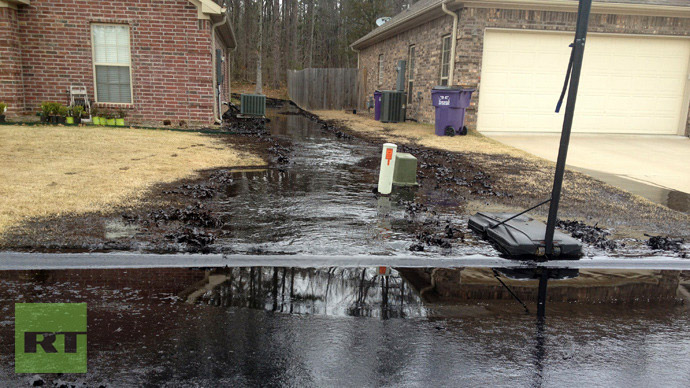
"Our regulations don't specify how much product a pipeline carries. There is no regulation if they want to change the type of crude they carry," said Damon Hill, a spokesman for the Pipeline and Hazardous Materials Safety Administration, a part of the Transportation Department to website insideclimatenews.org. "As far as reversing the flow of a pipeline, it is not a safety issue."
The Mayflower pipeline was built in the 1940s. While that may seem surprisingly ancient to some, many of the country’s pipelines are of a similar age.
“Over 50% of the nation's pipelines were constructed in the 1950's and 1960's during the creation of the interstate pipeline network built in response to the huge demand for energy in the thriving post-World War II economy,” a 2011 report by the US Department of Transportation revealed. “Some pipelines were built even earlier.”
Separately, local officials announced on Thursday that the drinking water and air quality in Mayflower do not pose a threat to the town’s inhabitants following the spillage.
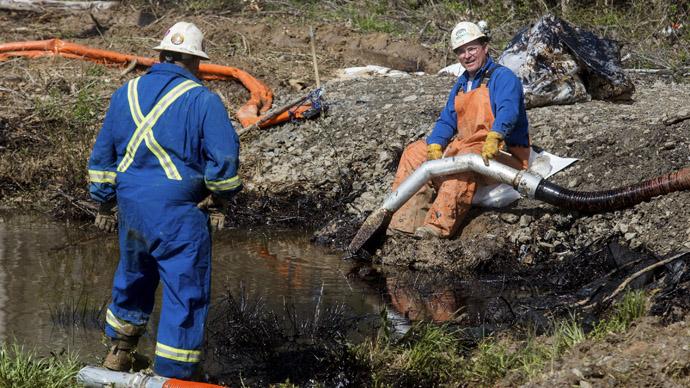
April 3
ExxonMobil has begun digging out residents’ oil soaked lawns and replacing them with fresh turf. However, the plan to excavate the area where the pipe ruptured in order to repair it remains under review.
Exxon may be able to avoid paying into a government oil cleanup fund, leaving the American taxpayer to foot the bill for the Mayflower spillage, David Turnbull, campaign director for Oil Change International, told RT. He says that the substance being transported in the pipeline was tar sands oil and therefore was exempt from the Oil Spill Liability Trust.
“The IRS has classified tar sands as different from conventional oil, and thus the tax levied to fill the liability trust fund is not levied on tar sands crude. It's a loophole that should be closed, as it doesn't line up with the actual intent of the tax or the fund,” David Turnbull told RT.
The Federal Aviation Administration has changed the conditions of the no-fly zone above the Mayflower oil spill to allow for media access, said spokesperson Lynn Lunsford in an email. She said it was amended because “there is no reason to keep media out.”
"It should have contained a provision to allow media over flights from the beginning, so we corrected it as soon as we noticed the error," Lunsford said.

April 2
The Federal Aviation Administration (FAA) announces a no-fly zone over the Mayflower oil spill, igniting speculation that ExxonMobil is trying to curb press coverage of the spillage. The no-fly measure, which will stay in place “until further notice,” is under the control of Tom Suhrhoff, aviation advisor to ExxonMobil. The ban applies specifically to aircraft flying at 1,000 feet or lower, inciting suspicions it is purposefully aimed at press helicopters.
“They are using at least one helicopter to provide aerial support for the cleanup,” Lynn Lunsford spokesperson for the FAA said.
“For safety reasons, they asked us to protect the airspace 1,000 feet above the area to allow the aircraft to move as needed.” Mayflower resident Chris Harrell tweets that Exxon had told the town’s inhabitants that their claims would only be processed after the cleanup had been completed. The company did not specify when this would be.
The Arkansas Attorney General has launched an investigation into the ExxonMobil spillage. Exxon spokeswoman Kim Jordan said that the company will cooperate with the investigation wherever necessary and that they were developing a plan to dig down and repair the rupture. Exxon has still been unable to say how long the cleanup will last and when the oil pipeline will be operational again.
Meanwhile, cleanup teams have reportedly recovered 14 "oiled" ducks, two turtles, and one muskrat from the oil slick. They have been sent for treatment.
Poor little guy. Clarksville volunteers helped wash tar-covered birds who got oil from the Mayflower spill. twitter.com/5NEWSJocelyne/…
— Jocelyne Pruna (@5NEWSJocelyne) April 2, 2013
In response to questioning over whether or not Exxon intended to cover the full costs of the cleanup, the company states it was providing full compensation for local residents.
Exxon is “paying all valid claims relating to the spill and providing interim housing for people from the homes which the city of Mayflower recommended be evacuated following Friday's spill.”
According to legal guidelines the diluted bitumen that inundated Mayflower is not technically oil, which could exempt Exxon from contributing to the government’s oil spillage cleanup fund.
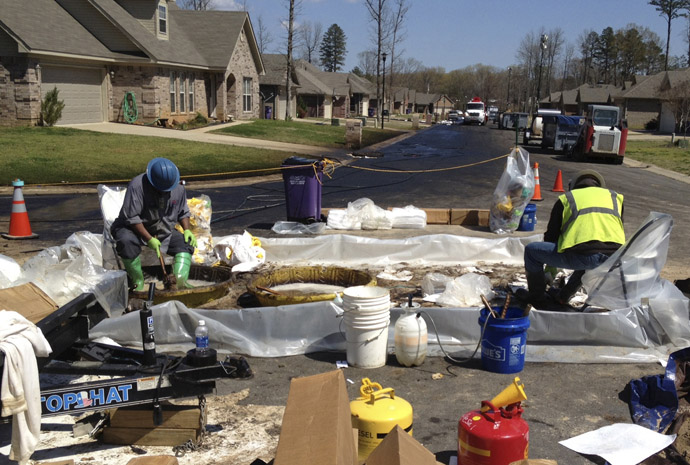
April 1
Arkansas Attorney General Dustin McDaniel launches an investigation into the spill and urges ExxonMobil to preserve all documents and information related to the accident and ongoing cleanup. ExxonMobil pledges to develop a plan for the phased return of the residents of all 22 evacuated homes.
Residents voice worries about the long-term effects of the disaster and what they will do to the local economy.
"The major concern for many people in our neighborhood is the long-term impact, both environmentally and financially. For example, what is this going to do to our property values?" said resident Chris Harrell to Reuters.
Meanwhile, White House spokesman Jay Carney said on Monday that he had not yet discussed the Arkansas pipeline with President Obama, but insists that the government “takes the safety of our many pipelines in this country very seriously…and, in cases like these, investigations are undertaken and steps are taken to mitigate the damage and hopefully avoid them in the future.”
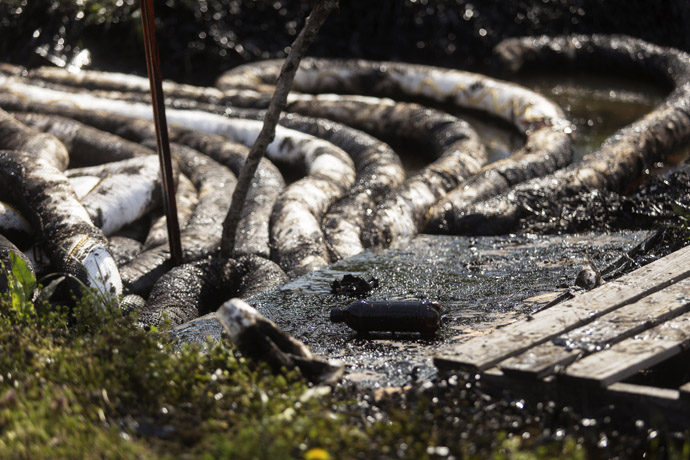
31 March
Police set up a checkpoint isolating the oil spillage as helicopters fly over the area and map the extent of the spill, an anonymous eyewitness told Reuters. The spill in the small town of Mayflower has sparked a debate over the environmental risks of using aging pipelines to transport heavy crude oil. Exxon has deployed 15 vacuum trucks, 33 storage tanks and 120 workers to the cleanup site.
Local news reports that journalists were barred from entering the spill site for 30 hours after the disaster.
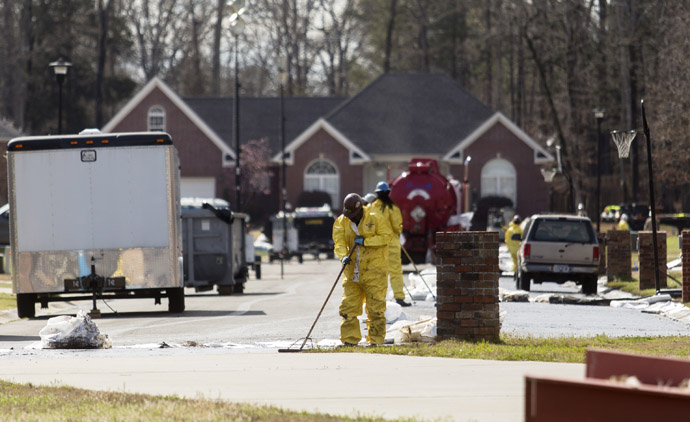
30 March
People have been evacuated from their homes as crude oil fills the streets of the town of Mayflower, causing havoc.
"The smell is quite horrendous both outside and inside our home. There is a strong smell of oil in our vehicles, as well," resident Chris Harrell told RT.
ExxonMobil has shut down the pipeline following the rupture and has begun preparing a response for a spill of over 10,000 barrels of crude. Clean-up crews have already recovered approximately 4,500 barrels of oil and water.

29 March
ExxonMobil’s Pegasus pipeline bursts near the town of Mayflower, Arkansas, inundating the town with over 10,000 barrels worth of crude oil.
Exxon released a statement on Friday night saying that there was no additional oil spilling and that additional trucks had been drafted in to assist with the cleanup.
The US Environmental Protection Agency has categorized the incident as a “major spill.”













